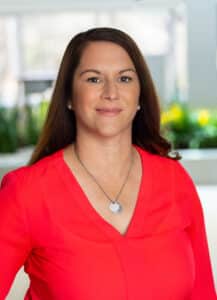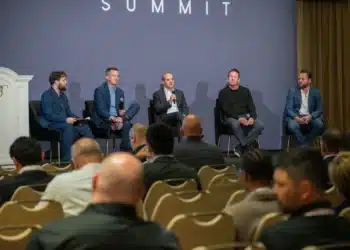5 questions with … Synchrony SVP of Credit Acquisition Strategy Anita Chalkley
Digital-first lender taps tech, data for decisioning for ‘credit invisible’ consumers
Anita Chalkley, senior vice president of credit acquisition at Synchrony Financial, draws on personal credit challenges to advocate for broader financial access.

The $119.5 billion digital-first parent of online Synchrony Bank is blending in-house credit decisioning tech and AI-powered data analytics with digital wallet platforms to expand payment options and credit access.
Stamford, Conn.-based Synchrony completed its acquisition of digital-first bank Ally Financial’s point-of-sale financing business to expand its financing solutions in the home improvement sector. The tool offers consumers both revolving and installment loan options, Synchrony said.
Consumers need payment options that cater to their credit experience, Chalkley told Bank Automation News.
Chalkley, who came to the U.S. from Australia, said she has personal experience with this. “I have a unique understanding of the struggles people who are new to the country or new to credit may have in accessing financial products,” she said. “It shaped my empathy and passion for helping people responsibly access credit.”
BAN sat down with Chalkley to discuss credit access and more. What follows is an edited version of the conversation.
Bank Automation News: How can financial institutions create pathways for people who are ‘credit invisible’ to establish a credit history?
Anita Chalkley: When I moved to the United States 15 years ago, I found myself being “credit invisible,” meaning I was unable to obtain credit because I had limited or no record or credit history with the credit bureaus. In Australia, where I was living previously, I owned a home, held credit cards and had a strong credit history. However, none of that positive credit history moved with me. I soon learned that “credit invisibles,” like me at the time, face extra challenges and costs in everyday living.
At Synchrony, given that we primarily offer credit through hundreds of thousands of businesses across the country, including companies like PayPal, Lowe’s and small- and medium-sized businesses, we see the full spectrum of Americans applying for credit. Synchrony offers a full suite of financial products, so we are more likely to be able to extend credit to those who are establishing their credit profiles or are “credit invisibles” or “unbanked.”
BAN: You’ve been with Synchrony in the United States since 2009. How have consumer needs evolved and what’s the approach to anticipating these changes?
AC: The biggest shift I’ve seen in consumer needs and preferences since I’ve been with Synchrony happened as we navigated through the pandemic and beyond.
With the rise of no-touch transactions, consumers embraced new technologies and forms of payment that make transactions more seamless, secure and faster. Whether paying with a card through a digital wallet, utilizing QR codes or applying for financing on a mobile device, consumers expect security and speed.
Earlier this year, Synchrony announced it is enhancing the way consumers securely shop online and in-app when checking out with Apple Pay on iPhone and iPad, adding fixed monthly payments as a financing option for eligible cardholders at checkout.
BAN: What new technology does Synchrony use for decisions on credit underwriting?
AC: Synchrony Prism helps tens of millions of Americans access credit responsibly and pay for the things that matter to them. This is a collaboration between the Synchrony technology and credit teams, focused on innovating credit and fraud decisioning, while improving the customer experience.
Prism is able to rapidly ingest hundreds of disparate data sources and, as a result, Synchrony has significantly expanded the number of data points assessed in credit decisioning to give a more holistic view of a customer’s creditworthiness … beyond just a traditional credit score.
By combining scores and attributes from multiple credit bureaus, engagement level data from clients, internal data from existing Synchrony Financial customers and attributes and insight from alternative data sources, Synchrony can instantly make better informed decisions. Increased data also reduces fraud by providing additional confidence that the applicant is who they say they are.
One key example of bringing alternate data into our decisioning is seen in our participation in Office of the Comptroller Currency’s Project REACh. Through this program, we have used permissioned bank and deposit account data combined with advanced underwriting techniques to approve people for their first credit card. Among all of the financial institutions participating in Project REACh, the banks have originated more than 100,000 new consumer accounts for applicants that previously had no, or limited, access to credit.
BAN: Who benefits from more inclusive underwriting strategies?
AC: We responsibly expand access to credit to more people who would not otherwise be able to obtain credit. Credit has the power to make daily life more affordable. One of the best ways to build credit is to demonstrate good financial discipline on credit cards, which can open the door to personal, auto or student loans, or mortgage loans.
More inclusive underwriting strategies also help fuel economic growth by providing consumers the opportunity to build their credit health while unlocking spending that benefits their lives and helps hundreds of thousands of U.S. businesses thrive.
BAN: Any updates in the pipeline for 2025 that have you excited?
AC: On the credit team, we are always focused on data and speed. We were the first to leverage customer-consented cash flow data in a retail setting and we will expand that capability in 2025 to more of our partners to increase their conversion and sales.
Autopay is helping us enhance the customer experience and our underwriting process. By implementing Autopay on Pay Later at account origination as an optional feature [in 2023], we have observed up to 4x separation in credit loss performance between enrolled versus not enrolled groups.
I’m excited to continue our partnership with the [Office of the Comptroller of the Currency] and our peer banks on Project REACh to expand the population of customers that we can help through this initiative.
Editor’s note: This article originally appeared in Bank Automation News, an Auto Finance News sister publication.
Auto Finance Summit East 2025 is set for May 12-14 at the JW Marriott Nashville featuring fireside chats with Santander Consumer USA and Chase Auto. Visit autofinance.live for more information. Early-bird registration is available here.











